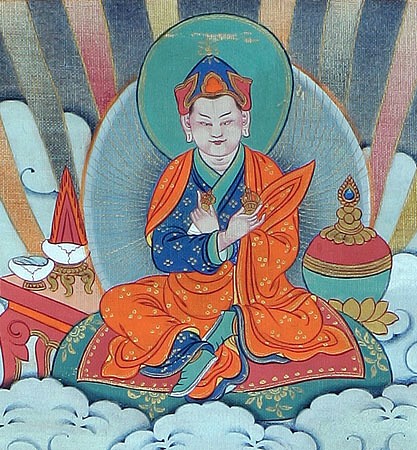Humkara: Difference between revisions
Jump to navigation
Jump to search
Stefan Mang (talk | contribs) No edit summary |
Stefan Mang (talk | contribs) No edit summary |
||
| Line 4: | Line 4: | ||
==Further Reading== | ==Further Reading== | ||
*[[Dudjom Rinpoche]], ''The Nyingma School of Tibetan Buddhism'', trans. and ed. Gyurme Dorje (Boston: Wisdom, 1991), pages 475-477. | *[[Dudjom Rinpoche]], ''The Nyingma School of Tibetan Buddhism'', trans. and ed. Gyurme Dorje (Boston: Wisdom, 1991), pages 475-477. | ||
* Bue, E.L. “The Role of Newar Scholars in Transmitting the Indian Buddhist Heritage to Tibet.” In Les habitants du toit du monde. Hommage ά Alexander W. Macdonald, ed. Karmay, et Sagant. Nanterre: Société d’ ethnologie, 1997: 629 - 658. | |||
[[Category:Eight Vidyadharas]] | [[Category:Eight Vidyadharas]] | ||
[[Category:Indian Masters]] | [[Category:Indian Masters]] | ||
Revision as of 13:28, 14 September 2016

Humkara (Skt. Hūṃkāra; Tib. ཧཱུྃ་ཀ་ར་, ཧཱུྃ་མཛད་, Wyl. hUM ka ra or hUM mdzad) — one of the eight vidyadharas of India; he received the Vishudda (Tib. Yangdak Heruka) tantra from the Kagyé cycle.
Further Reading
- Dudjom Rinpoche, The Nyingma School of Tibetan Buddhism, trans. and ed. Gyurme Dorje (Boston: Wisdom, 1991), pages 475-477.
- Bue, E.L. “The Role of Newar Scholars in Transmitting the Indian Buddhist Heritage to Tibet.” In Les habitants du toit du monde. Hommage ά Alexander W. Macdonald, ed. Karmay, et Sagant. Nanterre: Société d’ ethnologie, 1997: 629 - 658.